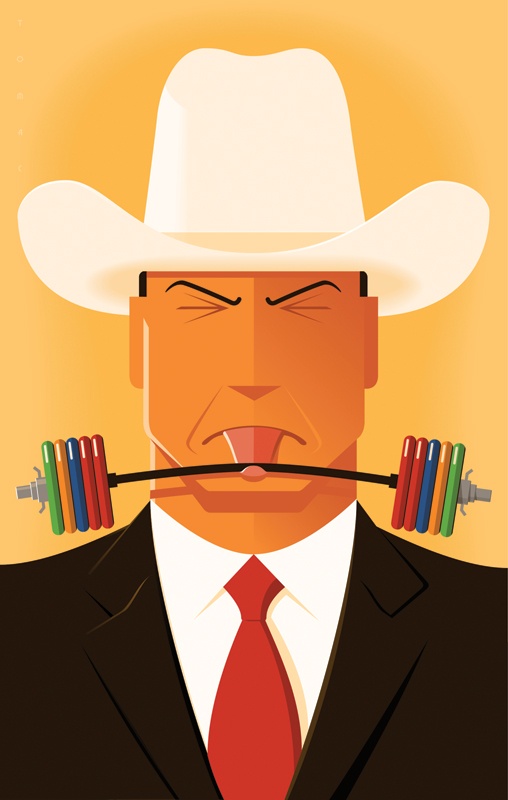A livestock handler throws open the gate, and a massive Hereford bull shoulders his way into the auction ring. The auctioneer starts his chant: “Five thousand, who’ll gimme five, how about a five, will ya make it five?” he asks in a rolling, rhythmic chorus. His voice is steady as a drumbeat with a leg-slapping, foot-patting cadence that pulsates through the crowd.
Just watch him, this man behind the auction block. He’s a showman. With swiveling head and one palm extended and upturned, he plays the crowd, alternately coaxing and urging the bidders. The rhythm is hypnotic yet urgent. Wow, now he’s even cutting words in half to rev up the pace, and his voice takes on the whine of a high-speed racing engine.
This isn’t just babble; in less than a minute, the deal’s closed, the bull exits the ring, and then the money changes hands. That old joke about an auctioneer so skillful he could get a crowd to bid on a pile of manure certainly fits this guy.
Is this some kind of live theater? Well, yes, in a way, but it’s also just another weekly auction at the local livestock sales yard—business as usual at markets all across Texas. Still, the person who fires off prices and waves in bids from the auction block is more than a fast talker. This auctioneer is the mediator, the agent between buyer and seller.
To see how difficult an auction chant is, just try a little yourself. Repeat these tongue twisters—straight from an auctioneering school in California—over and over, faster and faster until they can be repeated smoothly: “Round the rugged rock the ragged rascal ran,” or “Betty Botter bought some butter, but she said, ‘This butter’s bitter. If I put it in my batter, it will make my batter bitter.’ So she bought a bit of better butter, put it in her bitter batter, made her bitter batter better.” Whew!
In auctioneering schools, mastering the rhythm of the basic chant, “cattle rattle,” auction cry or “holla for the dolla” takes up a large part of the sessions. To get unfamiliar throats, lips and tongues in shape, students start at square one with something easy like: “One dollar bid, now two, now two, will you give me two? Two dollar bid, now three, now three, will you give me three?” The auctioneer just repeats the last bid and exhorts the crowd for a higher number—a higher price. Between the two figures, the auctioneer might add comments such as “Momma” or “Are you able to buy ’em?” or some other favorite jazzy filler to add a little pizazz and smarten up the flow.
Beginners who try for speed too early are amazed when teachers urge them to slow down a tad, to let their minds and mouths work at the same speed. Clear enunciation is the most important thing in the chant. They know that folks aren’t going to make a bid if they can’t understand what the auctioneer is saying. Speed comes later—and it will. These eager beginners slowly learn to string together a solid chant. Proper breathing methods start to strengthen the voice. Students learn ways to work a crowd to coax the highest possible bids.
Many auctioneers also use their hands constantly, but deliberately. Good ones never point a finger or blow a bidder’s cover. Waving bids toward himself or herself, palm facing inward, is worth money. The chant combined with gestures is designed to develop a sense of urgency and keep the crowd excited and bidding. Good auctioneers develop their own personal flourishes to electrify crowds.
Sure, you’ll hear the corny, ham-fisted jokes some auctioneers crack as they start the sale: For all you folks who have asked, the pigs are on sale in the porking lot! But a good auctioneer also knows how to clerk and cashier, read a livestock pedigree, appraise merchandise, advertise, choose a public address system and select a good sales staff. Many could even give stand-up comedians a tip or two on how to deal with hecklers in a cool and calm way.
Learning to display merchandise is also important. In a single-farm sale, everything from a prize heifer or a refrigerator to a soil auger, sofa bed or milk cow might be offered. If farm equipment or even posh household goods are piled up or left in a jumble, even the best wares look like so much junk.
After graduating from an auction school, a student of either gender is eligible to answer to the title of “colonel,” an honorary form of address that dates to the Civil War. Legend says that after a battle was over, the winning side auctioned off the belongings of the losers. The officer in charge of the auction often held the rank of colonel. Hence…
You may have wondered, as I have, when someone blinks at the wrong time or coughs or accidentally moves or waves a hand, if they’ve just bought that prize bull, rocking chair or tractor. No way. A reputable auctioneer would never hold anybody to an accidental bid.
Auctions have been a profitable and popular way to conduct business for centuries. Written accounts cite auctions in Babylon in 500 B.C. Not only do they move the goods, they also bring communities together. Auction day is a meet-and-greet social occasion for neighbors to gather from miles apart—the very essence of rural America.
And, who knows, you might pick up something. One of my friends met the love of her life at the stockyards, where he was calling out the “cattle rattle.” Another one picked up a bad case of the flu sitting next to a couple who was coughing and sneezing!
——————–
Juddi Morris lives in Gainesville.


